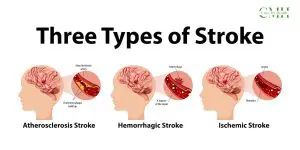Introduction
Ischemic stroke is a type of stroke that occurs when there is a blockage in the blood vessels that supply blood to the brain. It is the most common type of stroke, accounting for about 87% of all stroke cases. Ischemic stroke can cause significant disability and even death if not treated promptly.
Causes of Ischemic Stroke:
The most common cause of ischemic stroke is atherosclerosis, which is the buildup of plaque in the arteries that supply blood to the brain. Other causes include blood clots, which can form in the heart or other parts of the body and travel to the brain, and medical conditions such as sickle cell disease or vasculitis.
Symptoms of Ischemic Stroke:
The symptoms of ischemic stroke can vary depending on the location of the blockage in the brain. Common symptoms include sudden weakness or numbness in the face, arm, or leg, especially on one side of the body, difficulty speaking or understanding speech, vision problems, and severe headache. If you experience any of these symptoms, it is important to seek medical attention immediately.
Diagnosis of Ischemic Stroke:
Diagnosis of ischemic stroke usually involves a physical examination, imaging tests such as a CT scan or MRI, and blood tests to rule out other conditions.
Treatment of Ischemic Stroke:
Treatment of ischemic stroke is aimed at restoring blood flow to the affected part of the brain as quickly as possible. This can be done through a procedure called thrombolysis, in which medication is given to dissolve the blood clot. Thrombolysis is most effective if given within the first few hours of symptoms.
Another treatment option is thrombectomy, in which a catheter is inserted into the blocked blood vessel to remove the clot. Thrombectomy is a highly effective treatment for ischemic stroke and can be performed up to 24 hours after symptom onset in some cases.
Rehabilitation and Recovery:
After treatment for ischemic stroke, rehabilitation is often necessary to help the patient regain function and improve quality of life. Rehabilitation may include physical therapy, occupational therapy, and speech therapy, as well as support from a team of healthcare professionals.
Prevention of Ischemic Stroke:
There are several steps that can be taken to prevent ischemic stroke. These include maintaining a healthy diet and exercise routine, quitting smoking, managing high blood pressure, diabetes, and high cholesterol, and taking medications as prescribed by a healthcare provider.
Ischemic stroke is a serious condition that can cause significant disability and death if not treated promptly. If you or someone you know experiences symptoms of ischemic stroke, seek medical attention immediately. With prompt diagnosis and treatment, many patients are able to recover from ischemic stroke and regain function. Prevention is also key to reducing the risk of ischemic stroke.

Cold temperatures can cause vasoconstriction, or the narrowing of blood vessels, which can reduce blood flow and increase the risk of blood clots forming. Additionally, exposure to cold temperatures can lead to other factors that increase the risk of ischemic stroke, such as physical inactivity and respiratory infections.
It is important to take precautions during cold weather to reduce the risk of ischemic stroke, such as staying warm and active and managing underlying health conditions such as high blood pressure. Understanding the relationship between cold temperatures and ischemic stroke can help individuals take the necessary steps to reduce their risk and seek medical attention promptly if symptoms occur.
Why does decrease in temperature lead to the risk of Ischemic stroke?
There is a relationship between a decrease in temperature and an increased risk of ischemic stroke. Cold temperatures can cause vasoconstriction, which is the narrowing of blood vessels, and this can increase the risk of ischemic stroke. When the body is exposed to cold temperatures, the blood vessels in the skin and extremities constrict to conserve heat and maintain core body temperature. This can also cause the blood vessels in the brain to constrict, which can reduce blood flow and increase the risk of blood clots forming. Cold temperatures can also increase blood pressure, which can damage blood vessels and make them more susceptible to blockages. High blood pressure is a known risk factor for ischemic stroke.
In addition to vasoconstriction and increased blood pressure, exposure to cold temperatures can also lead to other factors that increase the risk of ischemic stroke, such as physical inactivity and respiratory infections.
It is important to take precautions during cold weather to reduce the risk of ischemic stroke, such as staying warm and active, and managing underlying health conditions such as high blood pressure. If you or someone you know experiences symptoms of ischemic stroke, seek medical attention immediately. With prompt diagnosis and treatment, many patients are able to recover from ischemic stroke and regain function.
Cold temperatures can cause blood vessels to constrict, which can increase the risk of ischemic stroke. This is because ischemic stroke occurs when there is a blockage in the blood vessels that supply blood to the brain, which can be caused by a blood clot or atherosclerosis (buildup of plaque in the arteries).
When the body is exposed to cold temperatures, the blood vessels in the skin and extremities constrict to conserve heat and maintain core body temperature. This can also cause the blood vessels in the brain to constrict, which can reduce blood flow and increase the risk of blood clots forming. Additionally, cold temperatures can cause an increase in blood pressure, which can also increase the risk of ischemic stroke. This is because high blood pressure can damage the blood vessels and make them more susceptible to blockages. It is important to take precautions during cold weather, such as wearing warm clothing, staying hydrated, and avoiding prolonged exposure to cold temperatures, in order to reduce the risk of ischemic stroke.

Cold temperatures have been associated with an increased risk of ischemic stroke. Ischemic stroke occurs when there is a blockage in the blood vessels that supply blood to the brain, and exposure to cold temperatures can contribute to this blockage. There are several mechanisms by which cold temperatures can increase the risk of ischemic stroke. One of these mechanisms is vasoconstriction, which is the narrowing of blood vessels. When the body is exposed to cold temperatures, the blood vessels in the skin and extremities constrict to conserve heat and maintain core body temperature. This can also cause the blood vessels in the brain to constrict, which can reduce blood flow and increase the risk of blood clots forming. Another mechanism is increased blood pressure. Cold temperatures can cause an increase in blood pressure, which can damage the blood vessels and make them more susceptible to blockages. High blood pressure is a well-known risk factor for ischemic stroke. Other factors associated with cold temperatures, such as physical inactivity and respiratory infections, can also increase the risk of ischemic stroke.
In summary, cold temperatures can increase the risk of ischemic stroke through vasoconstriction, increased blood pressure, and other factors. It is important to take precautions during cold weather to reduce the risk of ischemic stroke, such as staying warm and active, and managing underlying health conditions such as high blood pressure.
Conclusion
In conclusion, ischemic stroke is a serious medical condition that occurs when there is a blockage in the blood vessels that supply blood to the brain. It is the most common type of stroke and can cause significant disability or even death if not treated promptly. While there are several risk factors for ischemic stroke, exposure to cold temperatures has been associated with an increased risk due to vasoconstriction and other factors. Prompt diagnosis and treatment are essential in the management of ischemic stroke. Treatment options include thrombolysis and thrombectomy, which aim to restore blood flow to the affected part of the brain as quickly as possible. Rehabilitation is often necessary to help the patient regain function and improve quality of life after treatment.
Prevention is key in reducing the risk of ischemic stroke, and this can be achieved through maintaining a healthy lifestyle, managing underlying health conditions, and seeking medical attention promptly if symptoms occur. Understanding the relationship between cold temperatures and ischemic stroke can help individuals take the necessary steps to reduce their risk and seek medical attention promptly if symptoms occur.














